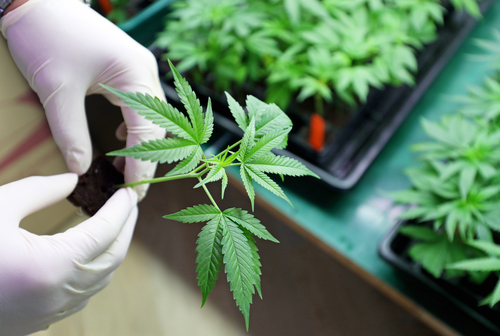Therapeutic Potential of Cannabinoid Compounds in Parkinson’s and LID Analyzed in Review Study

Cannabinoid compounds — particularly cannabidiol (CBD) — show potential to ease symptoms in people with Parkinson’s disease and levodopa-induced dyskinesia (LID), according to a review study.
Data also suggests that their therapeutic effects likely involve the direct modulation of critical messenger molecules in the brain and indirect reduction of brain inflammation.
However, future clinical studies are required to confirm these potential benefits in people with Parkinson’s disease and LID.
The review study, “Cannabidiol and Cannabinoid Compounds as Potential Strategies for Treating Parkinson’s Disease and L-DOPA-Induced Dyskinesia,” was published in the journal Neurotoxicity Research.
Parkinson’s disease is characterized by the presence of motor symptoms, including involuntary tremors, slowed movement, rigidity or stiffness, and impaired balance. However, it also can lead to a range of non-motor symptoms.
Long-term treatment with levodopa — the gold standard Parkinson’s therapy — leads to levodopa-induced dyskinesia (LID), or involuntary, jerky movements, in more than 50% of Parkinson’s patients.
Levodopa is used to ease motor symptoms by restoring the loss of dopamine — a key neurotransmitter, or messenger molecule in nerve cells — in these patients.
Both conditions (loss of dopamine and LID) are associated with changes in the basal ganglia, a brain region that contains the substantia nigra and the striatum and is involved in motor function.
Numerous studies over the past decade have looked at cannabis and its active components — known as cannabinoids — as potential treatments for motor symptoms in several neurodegenerative conditions.
Cannabinoids and other players of the endocannabinoid system — a complex modulatory network involved in brain development, memory, movement control, hormone production, and immune reactions — are known to have neuroprotective effects.
That is why “manipulation of the endocannabinoid system could be a promising therapy to control [Parkinson’s disease] and LID symptoms,” the researchers wrote.
A team of Brazilian researchers reviewed preclinical and clinical data on the therapeutic potential of cannabinoid compounds in people with Parkinson’s disease and LID.
Several studies have indicated that the endocannabinoid system — including the endocannabinoid anandamide and cannabinoid receptors — is altered in Parkinson’s patients and animal models of the disease, and that targeting it may prevent loss of dopamine-producing neurons, reduce inflammation, and ease Parkinson’s symptoms.
Evidence of an association between a dysregulated endocannabinoid system and LID is not as strong as that with Parkinson’s, but the team noted that there are still data suggesting that modulating this system, and in particular its receptors, may be a potential therapeutic approach.
“Among the cannabinoids investigated so far, CBD appears one of the most promising drugs in preclinical trials,” the researchers wrote.
CBD, the major non-psychoactive component in cannabis, is involved in a variety of important biologic functions. Preclinical studies have suggested that CBD regulates dopamine-dependent nerve communication by increasing dopamine levels, while decreasing the production of potentially harmful reactive oxygen species and pro-inflammatory molecules.
The team noted that “these anti-inflammatory and antioxidant properties may help explain CBD’s neuroprotective action.”
Most studies of CBD in Parkinson’s animal models have showed that CBD reduced the loss of dopamine-producing neurons and eased motor symptoms. However, others reported no significant benefit.
Data from clinical trials suggest that this cannabinoid eases symptoms in Parkinson’s patients, but a consistent beneficial effect on motor symptoms is still lacking. Furthermore, no clinical study has focused so far on the effects of CBD in reducing LID in people with Parkinson’s disease.
Some studies reported that CBD led to a reduction in psychotic symptoms, and improvements in emotional well-being, cognition, communication, and in mobility and body discomfort in Parkinson’s patients. However, these potential improvements in motor function failed to reflect differences in the total motor score, compared with patients receiving a placebo.
While several case reports, uncontrolled trials, and surveys suggest beneficial effects of cannabinoids in Parkinson’s patients, only four randomized placebo-controlled trials have analyzed the effects of different cannabinoids on Parkinson’s motor symptoms such as akinesia, tremor, or LID. Akinesia is the loss of the ability to move muscles voluntarily.
Only one of these trials, which evaluated the cannabinoid nabilone, showed a clear effect on motor symptoms with an ease in LID. Nabilone is a man-made form of cannabis often used to treat severe nausea and vomiting caused by cancer chemotherapy.
The authors also noted that growing evidence suggests that development of LID is associated with increased neuroinflammation, which may be potentially caused by levodopa and other Parkinson’s treatments. The beneficial effects of anti-inflammatory medicines to ease LID symptoms also reinforce inflammation’s contribution in LID.
Notably, preclinical studies suggest that a combination of CBD with compounds modulating specific non-cannabinoid receptors — associated with neuroprotective and anti-inflammatory effects and activated by endocannabinoids — may be an effective therapeutic approach to ease Parkinson’s motor symptoms and LID.
More clinical trials are required to clarify the therapeutic effects of cannabinoids in people with Parkinson’s disease and LID, and whether the combination with other compounds modulating neuroinflammation boosts their effects.






